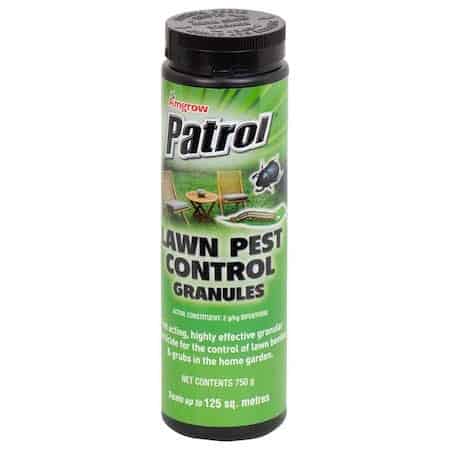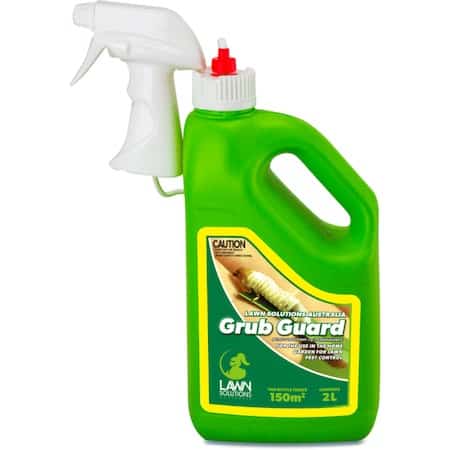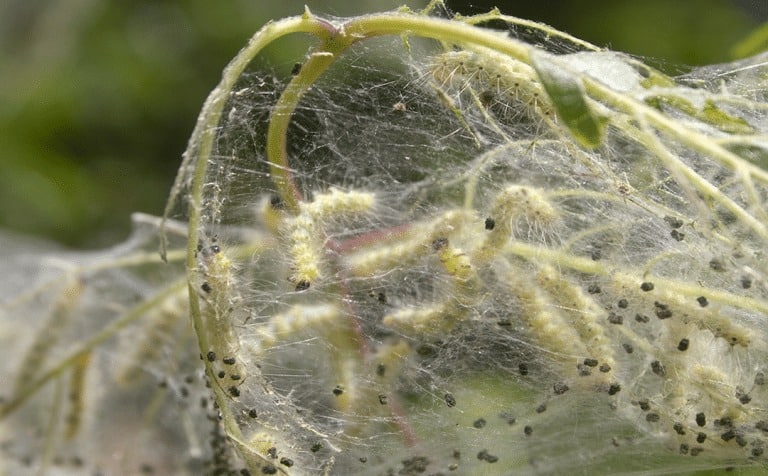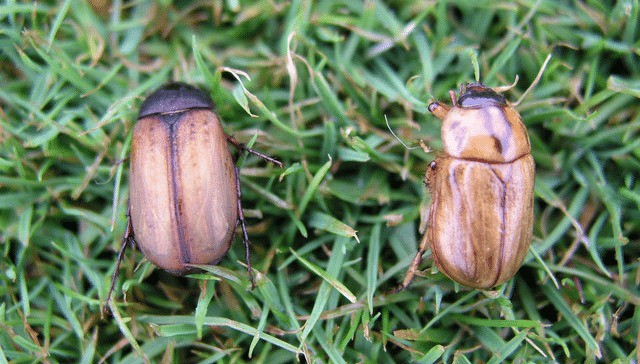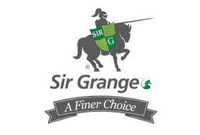Lawn Grub KIllers
Lawn grubs are a serious lawn pest that causes massive amounts of damage to Australian lawns every year. So many people ask ‘what’s the best lawn grub killer?’ And to answer that you first have to know your enemy.
There are a number of lawn grub species but mostly they live in the soil eating away at the root system of your beautiful turf. Lawn grubs are the larval stage of various adult moth species that lay their eggs in little cotton like cocoons.
And from spring through to autumn those little grubs unleash real devastation on any unprotected lawn.
How to Detect Grub Worms?
You can often spot an impending lawn grub infestation thanks to the tell-tale sight of battalions of a small greyish brown moths flying around your lawn at dawn or dusk.
Brown patches on your lawn are often a tell-tale sign of a lawn grub infestation.
Large numbers of birds foraging on your turf may also indicate the presence of lawn grubs.
Placing a wet hessian bag on the lawn overnight is also a good to check for certain types of lawn grubs existing beneath the soil surface.
Lift the sack in the morning and check for lawn grubs. The grubs feed at night and the sack will encourage them to the soil surface overnight).
Spraying a mild solution of water and dish washing detergent on a patch of lawn will also bring certain types of lawn grubs present to the surface.
How To Tell If Grubs Are Killing Your Grass?
The dying brown patches or bare patches on your lawn are the most obvious signs that lawn grub attacks are killing your grass.
A soft overly spongy feel when you walk across your lawn may also be evidence that lawn grubs are destroying your great turf.
You may be able to pull grass out easily—this can occur when the lawn grubs have eaten through the root system.
Will Grub Damaged Lawn Grow Back?
That depends on whether it’s a serious infestation, how long you leave it untreated and the grass variety.
Some lawn types such as Sir Walter Buffalo are pretty tough and will usually recover in the event even reasonable damage occurs.
Sir Grange Zoysia and TifTuf Bermuda grass types also feature exceptional pest resistance and strong recovery from damage.
Grass types such as Kikuyu and Couch are more susceptible to grass grub damage.
Lawn Grub Treatment Products
Grech’s Turf offer a number of highly effective tools for getting rid of lawn grubs for safe and effective control of grass grubs.
What Are The Best Lawn Grub Killer Products?
We offer effective grub treatment in both spray and convenient granular form applications.
The best lawn grub treatments will usually contain one of the following three active ingredients; Esfenvalerate, Bifenthrin, or Chlorantraniliprole.
Amgrow Patrol
Amgrow Patrol is a powerful granulated pesticide that delivers a highly effective kill rate for all types of grass grubs including White Curl Grub, Argentinean Scarab, Sod Webworm and Lawn Army Worm.
Application during the spring will eliminate most of the grubs before they become most active. The active ingredient, Bifenthrin, will kill most lawn grubs instantly on contact.
Acelepryn GR
Acelepryn GR is a highly effective lawn grub control and will kill all types of grass grubs including African Black Beetle, Argentinean Scarab, Sod Webworm and Lawn Army Worm.
Acelepryn GR contains Chlorantraniliprole and a single high dose application will control grass grubs for up to 6 months.
A single application in mid-September provides optimal results. Acelepryn GR has very low toxicity for non-target species including bees.
Its low toxicity means there are no PPE requirements for human protection.
Grub Guard
Lawn Solutions Grub Guard is a powerful broad-spectrum insecticide that is ideal to treat lawn grub attacks.
It comes with an easy spray applicator and will treat existing infestations as well as prevent new infestations by destroying the eggs.
Grub Guard contains Esfenvalerate and is moderately safe for most non target species.
Applying Grub Guard when the moths first appear or you first detect infestation signs provides optimal protection and minimises damage to your healthy lawn.
Lawn Grub Treatment Treatment (How To Treat)
How Do I Get Rid Of Grubs In My Lawn?
Using one of our approved lawn grub killers is the most effective way to treat any grass grub infestation.
These pesticides are designed to target grass grubs and if you apply them at the correct time they will provide lasting protection.
You may need to do a repeat application in case of any missed eggs or grubs.
When Should You Put Grub Killer On Your Lawn?
The best time to apply any lawn grub treatment is early in the spring (mid September) or immediately you detect any signs of the grubs.
What Is The Best Time To Treat For Grubs?
Most granular treatments are more effective if you apply them early in the evening when the grubs are actively feeding.
Do not apply after heavy rain, on waterlogged soil or if rain is expected within 24 hours as this may reduce the efficacy of the poison.
Does Soapy Water Kill Lawn Grubs?
Some people recommend using soapy water to kill grass grubs. This can work but it depends on the type of soap you use.
Use a solution of water and soap (you can obtain insecticidal soaps from gardening centres) and liberally saturate the lawn.
Ordinary dishwashing soap may smother some grubs and force others to the surface where hopefully the birds will devour them.
You may have some success with this method but it can be hit and miss.
How To Control Grubs Without Chemicals?
You can make your own insecticide by chopping up 4 large onions, 2 cloves of garlic and 4 hot chillies.
Add them together with some hot soapy water and let sit overnight. Strain that liquid off and dilute it with 5 litres of water. Spray this solution on your lawn.
Neem oil is another powerful insecticide. Removal of grass grubs by hand can also work well for tiny infestations.
Should I Apply My Own Grub Killer or Have a Professional Do It?
Our grass grub treatments are designed for ease of use by the home gardener.
Lawn Grub Prevention
Prevention is always the best cure even when it comes to grass grubs. Mow your lawns to a higher level.
Maintaining long healthy grass can discourage the moths from laying eggs as they like to lay their eggs close to the soil.
Avoid over-watering your lawn; grass grubs thrive in moist conditions.
Lawn Grubs
The term grass grub may refer to a large number of different lawn pests or grubs
White Curl Grubs
White Curl Grub is a common name for the African Black Beetle—see below.
The name comes from the white curl shaped larvae that live just below the surface and eat the grass roots.
A white curl grub infestation can do a lot of damage to your lawn if you don’t use an effective lawn grub control.
African Black Beetle
The African Black Beetle (also known as White Curl grubs) can quickly devastate large areas of lawn. Maintaining your lawn in good health helps to minimise their impact.
When the white curl grub larvae hatch and grow, from early November through to late January, is their most destructive period and when you’ll see these lawn grubs destroying your once normal and healthy lawn.
Armyworm
The term “Army worms” covers a number of different grass grubs.
The adult lawn armyworm announces its arrival with hordes of dull grey/brown moths flying over your lawn at dusk.
These moths will lay enormous numbers of eggs that produce light green or dark brown stripy caterpillars.
By sheer force of numbers of these caterpillars can do enormous damage to your turf often eating the grass down to soil level.
Fortunately, one of the safe but effective products from our lawn care store can easily deal with your army worm problem.
Argentinean Scarab
The Argentinean Scarab (Cyclocephala signaticollis) differs in appearance to the African Black beetles in that it is a tan colour highlighted by light stripes.
It’s widespread throughout NSW. The adult beetle lays huge numbers of eggs. These eggs hatch quickly into the ravenous scarab beetle larvae that do so much damage to turf.
Sod Webworm
The Sod Webworm is a light brown pest lawn grub critter that feeds on your grass blades at night time. They’ll grow to around 1.5cm long and can produce several generations in a year.
The most obvious tell-tale sign of sod webworms is the sight of light brown coloured moths flying in a zigzag pattern above your lawn as they lay eggs.
So there you have a summary of the most common nasty pests that can destroy your beautiful lawn.
You should always act quickly to get rid of lawn beetles, grubs and other pests.



